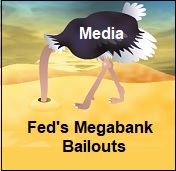-
Recent Posts
- Trump’s “Big Beautiful Bill” Is a Grotesque Giveaway to Fossil Fuel Billionaires While Adding $3.3 Trillion to Nation’s Debt
- Senator Chris Murphy Charges that Trump “Has Opened a Channel for Bribery”
- Congressman Casten: Trump’s Assault on the Rule of Law Is Causing Capital Flight Out of U.S. by Foreign Investors
- Trump’s Approval Rating Drops to 80-Year Low; IMF Says U.S. Tariffs Now Exceed the Highs During the Great Depression
- Nasdaq Has Lost More than 3,000 Points Since Trump’s First Full Day in Office in 2025; the Pain Has Barely Begun
- The Bond Crisis Last Week Was a Global No-Confidence Vote in U. S. President Donald Trump
- Trump’s Tariff Plan Guts $5 Trillion in Stock Value in Two Days; Senator Warren Calls for Emergency Action Before Markets Open on Monday
- Trump’s Attacks on Big Law, Universities, and the Media Have a Common Goal: Silence Dissent Against Authoritarian Rule
- Trump Administration Gives All Clear to Laundering Money through Shell Companies and Bribing Foreign Officials
- Four Megabanks on Wall Street Hold $3.2 Trillion in Uninsured Deposits – Which May Explain Senator Schumer’s Pivot to the GOP to Stop a Government Shutdown
- Here’s What Came Crashing Down Yesterday for Trump’s “Genius” Guy, Elon Musk: Tesla Stock, Access to Twitter (X), His Years of Secret Calls with Putin
- After Banning the Associated Press, Trump Is Now Targeting Specific Journalists That He Wants to See Fired
- Closely Watched Atlanta Fed Model Predicts Negative U.S. Growth in First Quarter
- Trump’s Gangster Diplomacy Makes Front Page Headlines Around the Globe
- Who Benefits Alongside Elon Musk If He Succeeds in Killing the CFPB: the Megabanks on Wall Street that Underwrite His Tesla Stock Offerings
- In Trump 1.0, the State Department Used Taxpayer Money to Publish a Book Elevating Elon Musk to a Superhero; It Was Funded by USAID, the Agency Musk Wants to Quickly Shut Down
- News Host Joy Reid Raises Threat of Trump Selling U.S. to Putin; Ten Days Later Her Show Is Cancelled
- Elon Musk’s DOGE Appears to Be Violating a Court Order; It Has Taken Down Hundreds of YouTube Videos that Educate Americans on How to Avoid Being Swindled
- Barron’s Releases Audio of Jamie Dimon Cursing Out His Workers at a Town Hall, as Dimon Plans to Dump Another One Million JPM Shares
- There’s One Federal Investigative Agency that Neither Trump nor Elon Musk Can Touch: It Just Opened an Investigation into DOGE
- Elon Musk’s Companies Were Under Investigation by Five Inspectors General When the Trump Administration Fired Them and Made Musk the Investigator
- Donald Trump Gives the Greenlight to Goldman Sachs and JPMorgan Chase to Return to Bribing Foreign Officials
- After Tech Geeks Built a Back Door to Loot Billions from FTX, Republicans Refuse to Investigate What Elon Musk’s Tech-Squad Did Inside the U.S. Treasury’s Payment System
- Former Prosecutor, Now U.S. Senator, Informs Tesla That CEO Musk May Be Violating Federal Law and to “Preserve All Records”
- Trump’s Hedge Fund Guy Is Now Overseeing the U.S. Treasury, IRS, OCC, U.S. Mint, FinCEN, F-SOC, and the Consumer Financial Protection Bureau
- As Elon Musk Begins Shutting Down Payments to Federal Contractors, a Strange Money Trail Emerges to His Operatives Inside the U.S. Treasury’s Payment System
- JPMorgan Chase Charged by Yet Another Internal Whistleblower with Cooking the Books
- We Asked Google’s AI Search Model, Gemini, Questions About the Fed and Wall Street Megabanks: It Got the Answers Dead Wrong
- With Trump and Melania’s Crypto Coins Likely to Raise Legal Challenges, Why Didn’t Trump Fire the SEC’s Inspector General in His Purge of IGs?
- Fossil Fuel Industry Could End Up Paying Tens of Billions for LA Wildfires and Deceiving the Public on Climate Change for Decades
- It’s Being Called the Biggest Grift by a President in U.S. History: Trump and First Lady Launch their Own Crypto Coins
- Trump Plans to Install a Fracking CEO to Head the Energy Department and Declare a National Emergency on Energy to Gain Vast Powers
- Fossil Fuel Money Played a Role in the Los Angeles Fires and the Push to Install Pete Hegseth as Secretary of Defense
- When It Comes to Wealth Retention in Retirement, Concrete May Be the New Gold
- Wall Street Watchdog Warns “Clock Is Ticking on a Coming Catastrophic Financial Crash”
- Wall Street Is Sending the Same Message to Americans on Fossil Fuel Financing that It Sent on Cigarettes: Drop Dead
- In a Six-Week Span, this Dark Pool with a Curious Past Traded 3.7 Billion Shares
- Wall Street’s Lobby Firm Hired Eugene Scalia of Gibson Dunn to Sue the Fed for Jamie Dimon
- Postmaster General Louis DeJoy Made $561,051 in Compensation in 2024, as Mail Costs Spiked and Delivery Deteriorated
- Fed Chair Jay Powell Sends a Bold Message to Trump and Tanks the Dow by 1123 Points
- The Head of Fixed Income at T. Rowe Price Makes the Scary Case for the 10-Year Treasury to Spike to 6 Percent
- $663 Billion in Cash Assets Have Gone Poof at the Largest U.S. Banks
- Donald Trump to Ring Bell at New York Stock Exchange Today as Hit List Posters Appear in Manhattan Targeting Wall Street CEOs
- Trump Has a Slush Fund to Prop Up the Dollar – Will He Use It to Prop Up Bitcoin Instead?
- A CEO Assassination; a Billionaire Heiress/NYPD Commissioner; a Secret Wall Street Spy Center – Here’s How They’re Connected
- Despite More than 1600 Tech Scientists Signing a Letter Calling Crypto a Sham, Trump Names a Crypto Cheerleader for SEC Chair
- The Fed Rings a Warning Bell: Hedge Funds and Life Insurers Are Reporting Historic Leverage
- Trump’s Nominee for FBI Director, Kash Patel, Has Businesses Financially Intertwined with Trump
- Donald Trump Is at Risk of Getting Named in a Fossil Fuels Conspiracy Lawsuit
- Trump Is Having Difficulty Getting a Lawyer to Accept the Nomination for SEC Chair: Here’s Why
Search Results for: Federal Reserve
Wall Street Mega Banks and Their Disgraceful Bailout Charts Since the Repeal of the Glass-Steagall Act in 1999
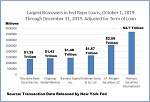
By Pam Martens and Russ Martens: August 15, 2023 ~ The Bill Clinton administration’s repeal in 1999 of the 1933 Banking Act, commonly known as the Glass-Steagall Act, ushered in the greatest kleptocracy America has ever known. The Cambridge dictionary defines “kleptocracy” as: “a society whose leaders make themselves rich and powerful by stealing from the rest of the people.” In fact, the actual goal of repealing Glass-Steagall was to do just that. The momentum for the repeal of Glass-Steagall came from the announcement in 1998 that Wall Street veteran, Sandy Weill, wanted to merge his trading firms, Salomon Brothers and Smith Barney (under the Travelers Group umbrella), with Citicorp, parent of the federally-insured Citibank commercial bank. Because of the Glass-Steagall Act, such a merger was illegal at the time. The 1933 Congress that passed the Glass-Steagall Act had watched the stock market lose 89 percent of its value over the years … Continue reading
Moody’s Cuts Credit Ratings on 10 Banks; Places 4 of the 15 Largest Banks in U.S. on Review for Possible Downgrade

By Pam Martens and Russ Martens: August 8, 2023 ~ Brace yourself for some tremors in the stock prices of banks today — especially those that have counterparty risk to the biggest U.S. banks. In a move that sent Dow futures on a steady downward plunge beginning at 5 a.m. EDT this morning (clocking in at down 268 points by 8:14 a.m.), last evening the credit ratings agency, Moody’s Investors Service, took more sweeping actions in the U.S. banking sector. Moody’s cut the ratings of 10 banks by one notch, placed six banks on review for potential downgrade, and changed its outlook to negative on 11 other banks. Causing particular alarm on Wall Street was the fact that four of the six banks that Moody’s put on review for potential downgrade rank among the 15 largest banks in the United States. They are: U.S. Bancorp, the 5th largest bank in the U.S. with … Continue reading
The 25 Largest U.S. Banks Are Seeing the Largest Fall in Deposits in 38 Years With No Signs of Letting Up
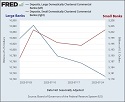
By Pam Martens and Russ Martens: August 7, 2023 ~ Deposits at the 25-largest domestically-chartered U.S. commercial banks peaked at $11.680 trillion on April 13, 2022, according to the updated H.8 data maintained at the Federal Reserve Economic Database (FRED). As of the most current H.8 data for the week ending on Wednesday, July 26, 2023, deposits stood at $10.709 trillion at those 25 commercial banks, a dollar decline of $970 billion and a percentage decline of 8.3 percent. Equally noteworthy, the decline shows no signs of letting up. According to the FRED data, between July 5 and the most current reading on July 26, the 25 largest U.S. banks shed $174 billion in deposits. Despite all of the misleading news reports about depositors seeking out the perceived safety of the largest banks since the banking crisis in the spring, it’s actually been the smaller banks that have staged a comeback … Continue reading
The Fitch Downgrade of U.S. Debt: What You Need to Know

By Pam Martens and Russ Martens: August 3, 2023 ~ At 5:13 p.m. ET on Tuesday, after the stock market closed, Fitch downgraded the U.S. credit rating from AAA to AA+. Fitch is now the second of the three major credit rating agencies to have taken the historic step of removing the triple-A rating from the U.S. S&P made its first-ever downgrade to the U.S. credit rating on August 5, 2011, also from AAA to AA+, and has kept it there ever since. Moody’s is now the only member of the Big Three credit rating agencies that has maintained a triple-A rating on the U.S. As the chart above indicates, the stock market responded negatively to this development yesterday, particularly over the fact that it came at a time when the U.S. Treasury is boosting the amount of debt it is issuing. Yesterday, the U.S. Treasury announced its plans to increase … Continue reading
This Chart Shows How Wall Street Banks and the Fed Have Become a Match Made in Hell
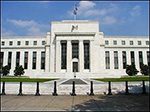
By Pam Martens and Russ Martens: July 24, 2023 ~ Prior to Ben Bernanke being sworn in as Fed Chair on February 6, 2006, the United States had been through World War I, the Great Depression, World War II, the Vietnam War and the stagflation of the 1970s, without an explosion in the Fed’s balance sheet. But since Ben Bernanke, Janet Yellen and Jerome Powell have, in turn, sat at the helm of the Federal Reserve, there has been unprecedented growth in the Fed’s Balance Sheet. For example, from June 1960 to August 1990, the Fed’s balance sheet increased from $53 billion to $309 billion – an increase of 483 percent in 30 years. But during the tenures of Bernanke, Yellen and Powell, the Fed’s balance sheet has exploded from $805 billion in February 2006, when Bernanke took his seat as Fed Chair, to the current reading last Wednesday, July 19, … Continue reading
Swiss Government Plans to Lock Away Secrets on Credit Suisse Collapse for 50 Years

By Pam Martens and Russ Martens: July 18, 2023 ~ The “Deep State” is increasingly feeling like the “Deep Banking State.” Try to get any meaningful information to unravel the corrupt and dangerous interconnections between global banking behemoths today and some government or other entity has slapped a padlock on the information. The latest example is the Swiss Parliamentary Commission of Inquiry that is delving into the collapse in March of the second largest global bank in Switzerland – Credit Suisse. The Commission has announced that it plans to lock away the details of its findings for 50 years. (UBS, the largest global bank in Switzerland, bought the crumbling remains of Credit Suisse earlier this year.) Reuters reported that the Swiss Parliamentary Commission of Inquiry is also requiring that “All persons participating in the meetings and the questioning are subject to the duty of secrecy, not only the members of … Continue reading
Senator Elizabeth Warren Slams Treasury Secretary Yellen and Bank Regulator Hsu for “Courting Disaster” on Bank Mergers
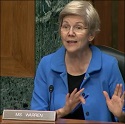
By Pam Martens and Russ Martens: July 13, 2023 ~ Senator Elizabeth Warren is the Chair of the Senate Banking Committee’s Subcommittee on Economic Policy. She is also the most knowledgeable member of Congress when it comes to the mega banks on Wall Street and the most willing to hold them accountable. (See related articles below.) Yesterday, Warren’s Subcommittee held a hearing on “Bank Mergers and the Economic Impacts of Consolidation.” The urgency of this hearing was heightened by the fact that almost two years after President Joe Biden signed an Executive Order urging members of his administration to take a more aggressive investigation into the harmful impacts of consolidation and monopoly power before approving more mergers in a number of industries, including banking, bank regulators signed off on one of the most egregious mergers of this century. Senator Warren explained it this way: “When First Republic Bank collapsed in April, … Continue reading
Large Banks Have Bled $921 Billion in Deposits Since April 2022 — the Fastest Pace in 40 Years — and a Much Larger Decline than Small Banks
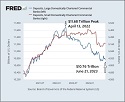
By Pam Martens and Russ Martens: July 6, 2023 ~ You may recall reading a burst of headlines during the banking crisis in March of this year about depositors fleeing small banks for the perceived comfort of the largest banks. Unfortunately, those headlines were never put in context or updated to reflect a broader picture. In fact, using deposit data that is updated weekly from the Federal Reserve’s own H.8 releases, it becomes crystal clear that the large banks are bleeding deposits at the fastest pace in 40 years. As the Federal Reserve data in the chart above indicates, deposits at the largest 25 commercial banks in the U.S. peaked at $11,679,758,700,000 on April 13, 2022. The most recent H.8 release shows that the deposits of the 25 largest banks as of June 21 stood at $10,758,977,000,000. That’s a percentage decline of 7.88 percent or $920,781,700. The Fed’s H.8 data defines … Continue reading
These Charts Show Why the Fed Is Terrified to Stop Raising Interest Rates and Why Nasdaq Is Ripping Higher
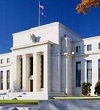
By Pam Martens and Russ Martens: July 5, 2023 ~ The top chart above shows one of the most erratic eras in Federal Reserve policy-making history. In the 70s and early 80s, the Fed would slam on the brakes to bring down inflation by raising its benchmark rate (known as the Fed Funds rate), then slam its foot on the gas to revive the economy by cutting the Fed Funds rate. But because the Fed stopped raising rates too soon each time, it had to then raise rates to an ever staggering level to curb runaway inflation, eventually reaching over 20 percent in 1981. Today, the Fed is woefully mindful of these mistakes. It is hoping to signal that it is planning higher interest rates for longer and follow through on that signal without killing the economy, and the markets, and the banks, and consumer confidence in the process. The Fed … Continue reading
This is the Bank Chart that Is Alarming Fed Insiders
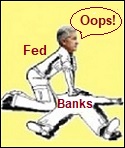
By Pam Martens and Russ Martens: June 27, 2023 ~ Between March 10 and May 1 of this year, three of the largest bank failures in U.S. history occurred. On March 10 the Federal Deposit Insurance Corporation (FDIC) seized Silicon Valley Bank after $42 billion in deposits had exited the bank the day prior with another $100 billion queued up to leave the next day – meaning it was possible for a federally-insured bank to lose 85 percent of its deposits in the span of 48 hours in the digital age. (For a closer look at what was going on at Silicon Valley Bank, see our report: Silicon Valley Bank Was a Wall Street IPO Pipeline in Drag as a Federally-Insured Bank; FHLB of San Francisco Was Quietly Bailing It Out.) Two more bank failures followed in short order: Signature Bank on March 12 and First Republic Bank on May 1. … Continue reading

